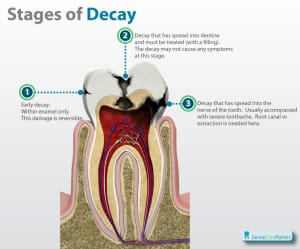People often seek out dentists when they start experiencing tooth pain, but often, a surface cavity has been festering long before pain strikes. In fact, 92 percent of adults ages 20 to 64 have had cavities in their permanent teeth.
Part of the fear of seeing the dentist comes from the unknown. If you have the beginning stages of a cavity – known as a smooth surface cavity – will you need a filling? A root canal? An extraction? Every case is different, but we have outlined the general lifecycle of a cavity so you know what to expect.
The Early Signs of Decay
Tooth decay is caused by the wearing away of enamel – the tooth’s hard surface layer – by acid in the mouth. Acid is either caused by the continual consumption of acidic foods and beverages (like soda) or produced by plaque, the sticky substance on your teeth that feeds on sugar.
Dull spots may appear on a tooth, leading to a surface cavity and, eventually, a full-blown cavity. At this point, the cavity can be prevented with diligent dental care. Brushing with fluoride toothpaste, flossing, and regular dental cleanings are great preventative measures.
A Developing Cavity
Once the spot becomes a hole, it is officially a cavity. The enamel has worn away or broken below the surface, exposing the dentin underneath. Cavities at this stage usually don’t exhibit painful symptoms and can be difficult to detect on your own. This is why it is important to have regular checkups with the dentist – so that the cavity can be filled before more damage is caused. Smooth surface cavity treatment may require a dental filling, but using fluoride to remineralize the tooth surface may sometimes suffice.
Dentin Decay
At this stage, the tooth has eroded the enamel and is starting to erode the dentin underneath. If you start to feel any kind of pain in your tooth, it is your tooth’s way of telling you to get to the dentist as quickly as possible. Once the cavity has reached the dentin, it will start to decay more rapidly.
At this stage, a dentist like Dr. Ritzau can still repair the tooth with a filling as long as the decay hasn’t gotten past the dentin.
Advanced Tooth Decay
Once the decay has eaten through the dentin, the only thing left is the pulp. Exposure of the pulp is extremely painful and hard to miss. The bacteria in your mouth can infect the pulp, causing the blood vessels and nerves to die. This is very serious and can only be fixed with a root canal.
An Abscess Develops
An abscess occurs when the pulp is infected by the onslaught of bacteria in your mouth. The bone surrounding the tooth can also become infected, and severe pain and swelling are common. An abscess causes serious infections that can be fatal if not dealt with. If you have allowed your teeth to reach this point, a root canal or possibly even an extraction will be necessary.
Protect Your Smile at Your Orange County Dentist
Cavities go through many stages, from discoloration to a surface cavity, to a more serious cavity, and possibly, an infection. However, there are warning signs before progressing to the last stage. Now that you know the stages and what to expect, you can take the necessary steps without fear of the unknown.
If you’re wondering how to get rid of surface cavities before they develop into something more serious, wonder no more. The best way to prevent cavities is with good oral hygiene and regular visits to Dr. Ritzau’s office.

